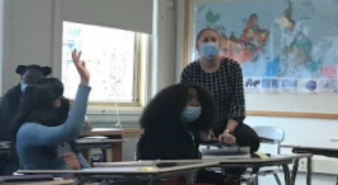
Students in Racial Awareness understand the importance of engaging in conversations about race at the high school, as this influenced their application.
Senior Elliot Lazarova-Weng applied for Racial Awareness because he believed a course centered around conversations about race was necessary to his education. He also noticed a disturbing absence of these discussions within the mainstream curriculum. Yet, the course fell short of what he had envisioned.
Currently the course is led by math teacher Hayley Wells and science teacher Karen Wong. As outlined in the syllabus, the goal of the seminar is to explore the complexities of race and racism, yet Wong has a slightly smaller personal objective.
“At the end of the year, I just really want to see that students have gained just a little bit more knowledge and a little bit more awareness than they had in September,” Wong said.
As discussions surrounding race continue to be integrated into the school’s curriculum, some faculty have discussed making Racial Awareness a graduation requirement. Wong confirmed that this has been an ongoing conversation within the administration. She said that this addition would not happen in the near future.
Racial Awareness is an elective course where a group of sophomores, determined through an application process, explore the prevalence of race within national, local and high school communities.
Founder and METCO Coordinator Malcolm Cawthorne originally thought of the course while taking a professional development class on race and equity. This resulted in a new revelation for Cawthorne.
“I realized in my classes that there wasn’t a lot of structured space for kids to have conversations around race. My feeling was that kids actually really wanted to have those conversations,” Cawthorne said. “I think more importantly they wanted to have some type of structure. One of the scary things when talking about race is that people are afraid of saying the wrong thing. But if there’s a teacher there, if there’s a structure there, that provides a sense of security for some.”
Years after Cawthorne led the course and new teachers have taken over, seniors Lily Lockwood and Alejandra Mineo-Levitsky said the class might no longer achieve Cawthorne’s goal. Lockwood said many students don’t elect to take the course with the same intentions, which thoroughly affected the culture within the classrooms.
“I think a lot of people took it because of the free blocks and the field trips, and because it would make them look good, not because they actually cared,” Lockwood said.
Mineo-Levitsky said students of color, including herself, were disproportionately targeted to be used as facilitators.
Mineo-Levitsky shared that as a Latina person, she felt much of her time was spent educating her peers.
“It felt like for me, as a Latina, a lot of the time was not really spent in a positive way for myself. It was mostly educating other people, which was not really what I signed up for,” Mineo-Levitsky said.
Lazarova-Weng said he found that class discussions often didn’t go past surface level when exploring race. He observed that the class catered more towards protecting Caucasian students’ comfort.
“In terms of race, you are never going to feel comfortable so long as you’re actually talking about it. I don’t think that it’s a topic you can explore and learn about without being uncomfortable. But I think that’s the whole thing with BHS. They always want to build safe environments,” Lazarova-Weng said.
Sophomore Ivy Fawcett, a current student in Racial Awareness, said she is experiencing a positive atmosphere in her classroom. Fawcett said a culture has developed where students are able to have differing opinions and educate each other as well as themselves.
“Personally, I’ve always felt like I’ve been able to speak my mind. I know that if I say something incorrect or that doesn’t align with someone else’s ideas, someone will correct me or at least do a good job of staying kind,” Fawcett said. “I personally believe that it should be mandatory, because I’ve learned so much from it.”
Lazarova-Weng said for any requirement to happen he thinks there needs to be more focus on how the course may affect students of color.
“While I think it’s important to have courses like this, if we were to make it mandatory, there are students who have gone through trauma surrounding their race, who do not want to go into school and have to relive that. I think it needs to be a choice whether you want to deal with that in school or not. Especially for students of color, some people just want to go to school and be able to forget and focus on their learning,” Lazarova-Weng said.
Lockwood said she had conflicting ideas about the class being required. She said while the content was important to learn, the element of it being a choice was a key component.
“If you force people who don’t actually care, who don’t actively want to learn, then you have such an unhealthy class environment, and you don’t actually learn any of the things that you’re trying to emphasize,” Lockwood said.
Racial Awareness class sparks conversation
Molly Louison, Staff Writer|January 9, 2022
KYLA FREY/SAGAMORE STAFF
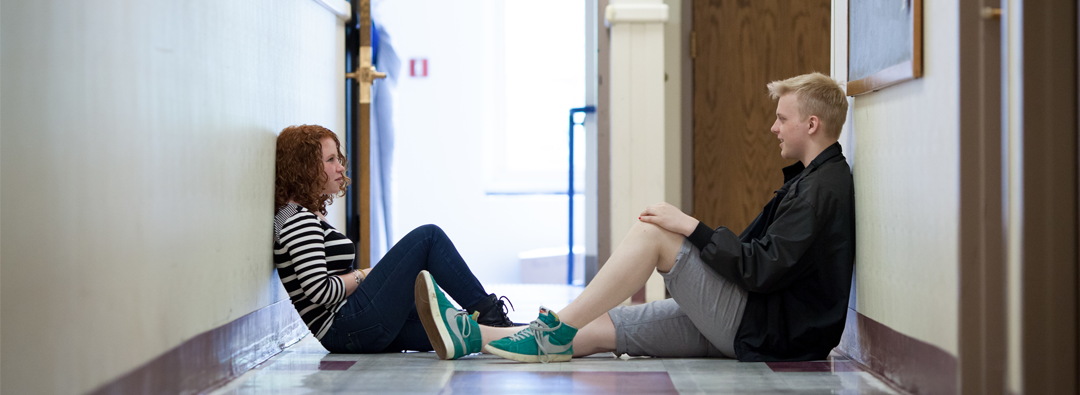
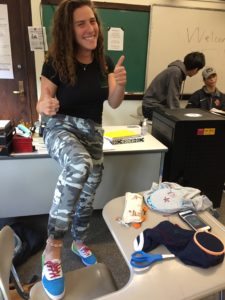 Brookline High School alumna Maya Rozen interviewed current students about their experiences participating in BHS Innovation Fund courses. Hear the impact of the Innovation Fund at BHS in the students’ own voices.
Brookline High School alumna Maya Rozen interviewed current students about their experiences participating in BHS Innovation Fund courses. Hear the impact of the Innovation Fund at BHS in the students’ own voices.
Many of the courses offered at BHS revolve around a curriculum that students are required to take, which is why many students relish the academic opportunities that grant them more freedom to explore other areas of study more on their own terms. For students interested in engineering, Engineering by Design is a great class that allows students to explore different areas of engineering and design and to pursue projects that they are passionate about. Other classes like Social Justice and Racial Awareness provide a safe space for students to learn about important topics with the freedom to share their own thoughts, experiences, and beliefs. Many of these classes allow students to explore new subjects that aren’t always covered in the required curriculum.
In your opinion, what makes your Fund class different compared to your other classes?
“Something that stood out to me about the class was the amount of freedom we had because I kind of expected it to be really structured with a lot of rules, but I found that with all of the projects there was a lot of room for our own ideas and a lot of room for creativity, which I liked.”
~Sarah S., BHS ’21, Engineering by Design
“I think since you have to apply, everyone who is in the class is really interested in social justice and wants to be there. It’s not like people are taking it just to check it off the list or just to say they took it. I can see people who were in my class that are now doing things on their own time, whether they have an internship, or they’re volunteering, or they’re just doing research and finding ways to work on the issues that we learned about. I also think that since everyone wanted to be there, people really opened up because we’re all so passionate about it. Everyone’s open to hearing the perspective of other people who are passionate and I think a lot of that comes from Ms. Leslie because she has so much passion. You can see when she’s teaching that she wants to be there so much and she wants to give us all this knowledge of what is actually happening, and then give us the freedom to talk about what we think, and that is something that I often don’t find in a class.”
~Aine D., BHS ’21, Social Justice
As a ninth grader entering BHS, the thought of graduation seems as if it is a million years away. Freshman and sophomore years pass by in the blink of an eye, and then suddenly you’re in your junior year and it’s time to begin figuring out what your next steps will be after you graduate high school. Some students go through high school with a clear idea of what those next steps are whether it’s pursuing a certain career or studying a specific major in college, but for many students this is not the case. Having the opportunity to try out different classes can expose them to new subjects and inspire new interests. Many students find that classes like Social Justice can lead to new interests that they are excited to continue pursuing after high school. Aside from exposing students to new topics, these classes also teach students very valuable skills that they don’t always learn from their required courses. Tutorial helps many students learn how to better manage their time and their work, teaching them valuable skills such as organization, time management, and how to plan out their week. Other classes like Racial Awareness can help students feel more comfortable going out of their comfort zone through being exposed to new points of view or learning how to have tough conversations. All of these skills are very important to have during their time at BHS and beyond.
How has the class shaped who you are as a student? How have you grown as a result of this class?
“As a student, I noticed as I was taking this class that before I tended to make more assumptions about people, and this class has helped me think about the reasons I’m doing that and how not to act on those assumptions, and I think I definitely have grown from taking this class.”
~Kate C., BHS ‘22, Racial Awareness
“I think I’ve grown a lot in the way that I feel like I can voice my opinions more if someone brings up an issue. I feel like I have the knowledge and the power to actually voice my opinion because I’ve learned about it. I think that a lot of times now I’ll hear conversations going on and I’ll actually know what they’re talking about which I think is really cool because I can participate in the conversation. Now more than ever I feel like I can help. I have so much of an understanding of what’s going on, so I can really help and try to help other people try to understand what’s going on.”
~Zoey F., BHS ‘22, Global Leadership
“I think I’ve grown in my abilities to ask for help and to make sure that I have a plan for the week for my assignments and projects and when I should be doing them. I think my experience would be a lot harder, I would be less organized, and I don’t think I would get as much work done without tutorial.”
~Declan T., BHS ‘22, Tutorial
“I think that I’ve been able to want to have the uncomfortable conversations. A lot of times people don’t want to talk about a certain thing because they know people have conflicting points of view or that it affects someone personally and they don’t feel like it’s their place to talk about it. This class made me realize that you can have a voice, but it’s also really important to listen, and listen to the uncomfortable conversations and be able to ask questions and be able to talk about it even though it might be uncomfortable.”
~Aine D., BHS ‘21, Social Justice
Many classes like Global Leadership and Social Justice offer students the unique opportunity to learn about current, important topics while simultaneously engaging in real world problem solving and solutions. Fundraisers, volunteering, and peaceful protests are some of the many ways where students can feel like they are not just doing the important learning, but also feel like they are making a real difference and contributing to the solution.
Can you describe some of the most memorable parts of the class and talk about a couple of your favorite assignments?
“We were having a lot of meetings and conversations about the Black Lives Matter movement. We got to talk about them as a class and getting to hear from other people about what they’ve been doing and how they’ve been using the things that we learned from this class to contribute to this movement was great.”
~Kate C., BHS ‘22, Racial Awareness
“I think a lot of people will say this but definitely learning about the incarceration system. The prison trip is always something people talk about for a really long time. I was excited about the trip because I think the incarceration system isn’t something that we see on the news every day. When I sit down to watch the news, I don’t see them talk about all the oppression and discrimination that exists in the incarceration system. I think that it’s overlooked a lot so I really wasn’t aware of what was happening in the system, and being able to go to a prison and then talk to inmates was really cool because we could hear their first hand experiences and they were really honest. They talked about the guards there and how they’re not nice to them and what it’s like in solitary confinement. They were just really really honest about what’s happening, and being able to see that after watching movies about the incarceration system and what happens was really powerful, so that was the night that really stood out to me.”
~Aine D., BHS ’21, Social Justice
“One of the assignments we did was called the TAP Challenge which was where we raised money for clean water in Nicaragua, and we did that by starting a school campaign to have everyone bring their own water bottles and not use plastic water bottles for 25 days. We sold reusable water bottles and tumblers and also stickers. I thought it was really cool because it really felt like we were making an impact instead of just learning about the issue. I actually felt like I was doing something about it while still learning about it in class.”
~Zoey F., BHS ’22, Global Leadership

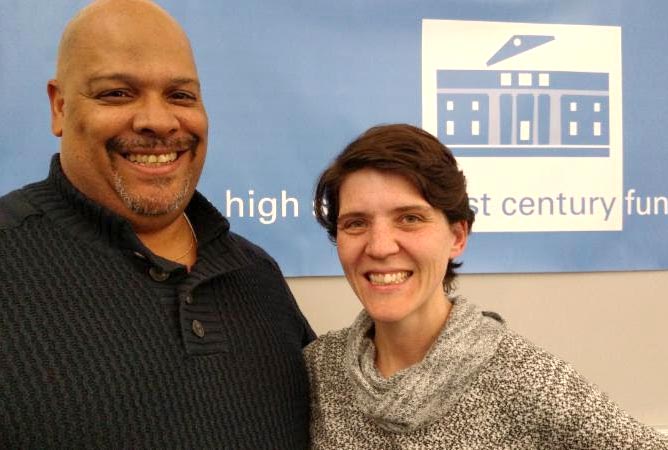 The Racial Awareness Seminar is a year-long sophomore elective that was seeded by the 21st Century Fund in 2016-2017. This seminar-style class is designed to foster students’ capacity to reflect on and speak effectively about racial identity, and to create a learning community that embraces and is empowered by the rich diversity of identities and perspectives at BHS.
The Racial Awareness Seminar is a year-long sophomore elective that was seeded by the 21st Century Fund in 2016-2017. This seminar-style class is designed to foster students’ capacity to reflect on and speak effectively about racial identity, and to create a learning community that embraces and is empowered by the rich diversity of identities and perspectives at BHS.
The following is an update submitted by teachers Malcolm Cawthorne and Kate Leslie in February 2017:
The Racial Awareness Seminar has been working toward the goal of understanding the complexities of race in the 21st century. Recently, our focus has been on students’ own racial identities. To think more deeply about this, we have been examining groups historically and currently viewed as “races” within the United States.
We have used the past to focus on the present. Students grappled with the idea that the only Asian identity box that could be filled in on the U.S. Census was “Chinese” until the 1900s. We saw how the growth of Chinatowns in American cities created a “one-size-fits-all” approach to immigrants from Eastern Asia, and we discussed the complexity ignored by this approach. For example, we recognized that the Middle East is also in Asia, and racial identities are sometimes connected to religious faith. These observations fueled exhilarating discussions.
A student explained the seminar’s effect in a reflection: “In the past quarter my thinking about race has changed so much! In Racial Awareness the way that we learn is so impactful. . . . Instead of being able to pinpoint certain things we learn every day, like parabolas and ionization, I can feel how I’ve changed as a person over time. In this class I’ve learned things like how to have a discussion about race. I’ve learned what racism really is and how to see it. I’ve learned how to have a voice in my head that goes against the one that makes assumptions. And most importantly I’ve been able to learn about other people’s experiences and what we have to change.”
In addition, this year’s students feel it is important to become leaders and share their knowledge. Five of our students joined the Anti-Defamation League in its work with Brookline High after the recent incidents of anti-Semitic vandalism. Two students have created an organization to examine Institutional Racism at BHS. Many students were involved with BHS’s “Asking for Courage” day in December.
This activism is organic. Many of our students have been inspired by the class to do “personal work,” outside of school. Students have attended meetings, movie showings and programs to gain a greater understanding of the issues. Some have worked to reach into communities they feel have been mis- or under-represented. Some have begun to read more for broader understanding. To bring it to the present, the kids are “woke.”
— Malcolm Cawthorne and Kate Leslie
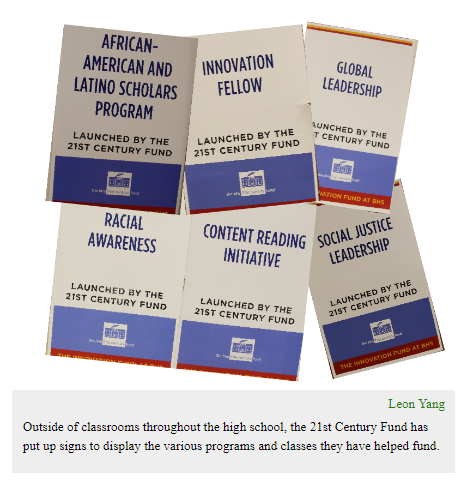
Leon Yang
Outside of classrooms throughout the high school, the 21st Century Fund has put up signs to display the various programs and classes they have helped fund.
Rachel Vin, Staff Writer
November 10, 2016
While many kids sit in class answering questions from traditional textbooks, visual arts teacher Thato Mwosa watches her students’ eyes light up as they work. Each one learns new skills and expresses themselves creatively as they make their own mini-documentaries for the newly introduced History as Film course.
This new course, as well as many other courses in the high school, was created by a teacher, and was put in motion with funding from the 21st Century Fund, which supports teachers in developing new programs for the high school. According to the fund’s mission statement, its purpose is “to empower the BHS faculty and community by fostering a culture of innovation and supporting the development of new ideas.”
By supporting new and creative courses, the fund provides both students and faculty with opportunities to advance their experiences beyond traditional methods and curricula.
Elizabeth Zachos, chair of the 21st Century Fund, said that one of the Fund’s main purposes is to supplement the high school in a way that is generally not offered.
“It’s about bringing learning opportunities to BHS students that are not typically available in a public school setting,” Zachos said. “Also, it’s about providing teachers with an opportunity to develop professionally outside the normal structure of teaching.”
Junior Liam Downey was involved in two 21st Century Fund courses last year: Global Leadership and Racial Awareness. Downey said that the structure of these classes was more unique than traditional academic courses.
“It’s definitely diversified the way I’m learning because you tend to learn along five courses, but these don’t really fit into any of those lines,” Downey said. “There weren’t a lot of notes or tests. It was more of a discussion based classroom.”
According to Spanish teacher Astrid Allen, who is also the Fund’s program liaison, teachers with ideas for new courses will often approach her. Her job is to help them build a proposal for this potential course or program, and this will later be presented to the Fund’s program committee.
“Part of my job is reaching out to the whole school community to find out if anyone has any innovative ideas that they want to move forward in some specific way and to bring that proposal to the program committee of the 21st Century Fund,” Allen said.
According to Zachos, if funding is approved for a new course, it typically goes through a trial period of two to three years. Some ideas are designed to be temporary programs, but for ongoing classes, the trial period tests the success of the course, which afterwards may be absorbed into the school budget as a permanent elective.
Mwosa co-teaches History as Film with social studies teacher and creator of the course Mark Wheeler. According to Mwosa, the creative aspect of the class makes students more engaged than they are in traditional history classes.
“This is sort of more active. I feel like the students are engaged and participating,” Mwosa said. “A big part of this class is being creative. You get to learn, but you get to be creative as well.”
Last year, the 21st Century Fund started a new program for teachers to produce fresh ideas called the Innovation Fellowship. According to Allen, The Innovation Fellowship chooses one teacher annually and alleviates their class load by one or two classes, giving them time to develop a potentially groundbreaking idea.
“They [21st Century Fund] wanted to give a teacher an opportunity to really follow a really innovative idea that would benefit the whole school and community,” Allen said.
According to Downey, the individual style of the classes allow students to learn what they’re passionate about without being restricted by curriculum requirements.
“It was taught where the teachers understood that we aren’t bound by a curriculum, but instead we were free to explore our own issues that we want to explore,” Downey said.
Allen said that the programs supported by The 21st Century Fund can expand a teacher’s career as well as the students’.
“The fund provides this opportunity for teachers to do something totally different, to use their expertise to create something that benefits students at the school where they see a need,” Allen said.
 Q: In your view, what is the Fund’s role at BHS?
Q: In your view, what is the Fund’s role at BHS?
A: I think the Fund’s role is to spur and foster innovation at the high school. To me that means supporting teachers and supporting really interesting ideas that would benefit kids. It could be regular classes, particular curricula, or it could be grants and programming. The Fund does that, in part, by putting really smart parents and community members in partnership with Brookline High and district staff, so we get the perspectives of smart parents and smart people in all kinds of different disciplines and industries, and that helps us think about the work that we do. When we had our breakfast Elon [Fischer] was talking about his very interesting work as Innovation Fellow, and what he heard in return were several ideas about how that work could be improved or looked at differently, and really, at the end of the day, supported. We had two premier design thinkers [at the breakfast] who’d done a whole lot of work. So, is it possible that Elon would have stumbled upon those people? Yes. Is it much more likely that the Fund helped put those people together? Yes. There’s a tremendous amount of energy and expertise in this community, and I think the Fund provides a key way to support the school using that energy.
Q: So that’s a way of bringing parents in, connecting them with teachers. In terms of drawing talented teachers into the school, is the Fund something that helps you in the hiring process?
A: Absolutely. We had a very specific example of that this year. We had a teacher who was set to co-teach Film as History/History as Film — this teacher left the school and district in the late spring/early summer — it was late in the game. It seemed like bad luck. We had a very interesting candidate for the position, but we were asking her to take less FTE to be here. The fact that one of her teaching assignments was going to be this very interesting co-teaching opportunity was an incredibly powerful draw. She ended up coming.
But to answer your question more broadly, there are so many incredible teachers here, and what has been clear throughout — at least in my history with the school, and what I’ve seen and heard — is that we find different ways for teachers to improve and increase their leadership skills. One of those ways is by creating a course or leading a program, supported by the 21st Century Fund. So Elon Fischer is a leader in this school, and the Fund’s Innovation Fellowship is a perfect way for him to work on and demonstrate that leadership. That to me is under the umbrella of retention. I absolutely believe that opportunities with the Fund help us attract and retain talented, committed teachers and support them to help lead the school. With a faculty and staff of this size you need all kinds of leaders.
Q: What challenges currently face BHS, and how does the Fund help to address them?
A: I think we need to look at all of our collaborations, all of our partners, and all the work that we do to focus on challenges. There are several challenges that come to mind. I would say the biggest is that we have a group of students who struggle here to engage, struggle to achieve in the ways we believe they’re capable of achieving. It’s not surprising that it’s the historically underachieving populations of students who don’t do as well here on various measures. It’s certainly not true of everybody in those populations, and it’s not unique to Brookline, but it’s true enough that we have an achievement gap. As we look forward to addressing that, we need to think about how to do it: How does our student support, how does our monitoring of kids increase and improve so that the net is raised higher, and the net is tighter? We need to think, instructionally, about how we’re making sure that excellent instruction targets kids who really struggle to engage. These are not novel ideas — they’re things that an institution like this is always engaged in. And I think there are opportunities with Fund courses — we can look at things that have already been experimented with in the Fund, and also programs and courses that we might want in the future, and ask how can they affect as many students as possible.
Tutorial is a really good example. To me there’s a tremendous opportunity that we’re embarking on to reconsider tutorial and think: OK, this has been a really important model. How do we use it even better and differently to make sure that we’re catching kids sooner, that we’re being flexible in the structures we’re using, and then zeroing in on re-teaching or supporting kids in what they need content-wise, as well as habits of learning? That’s what I’m interested in thinking through with the Program Committee and others: We have this course proposal, or we’re thinking about these courses — what will be the impact for the students in that course or in that program, and in what ways can those experiences be offered to more kids? It becomes an access issue. The Makerspace is a great example. It is overdue and so appreciated to have the Fund’s support to have Aubrey Love and Andrew Maglathlin work on a Makerspace. And it’s going to be a space for Engineering Innovation and Design, but then we think if we have this incredible space, and the district comes in and helps improve it also, how do we make sure that that space is accessed by as many kids as possible?
Another long-term benefit of the 21st Century Fund is that these courses might run for X number of years, but it’s safe to say that the experience of developing these courses should have long-term impact: What did we learn about how kids learn? Film as History/History as Film is not only a terrific opportunity for the students who are enrolled, but: What are we learning about interdisciplinary studies? We believe that more kids should experience that, so how do we build on this model? Many examples come to mind, but those are a few. To me, the central challenges right now are issues of equity and access.
A second and parallel issue is space. We’re moving towards a building renovation, so we’re thinking about how we organize a school that, in five years, will be over 2500 students. What does that mean about how we organize ourselves? What does it mean about the opportunities and supports we want to make sure all kids have? Then there will be the challenge of a school in the midst of a renovation: How do we continue to do what we do while having our spaces changed?
A third challenge is that there’s been a significant transition in leadership. All of these are real opportunities, and that for sure is an opportunity. It’s been great to welcome Andrew Bott and Nicole Gittens. Across the board, there’s quite a bit of change.
Q: So, tell us something about your personal interests. If you could take one of the 21st Century Fund’s classes, which would you choose?
A: Historically, if I could have taken Good Citizen in a Good Society, I think I would have loved that project-based class. It was a really interesting approach to English and History. The discussion about really meaty issues and ethics would be really interesting to me. It was thematic, so they would read things like the Tracy Kidder book Mountains Beyond Mountains, the one about Paul Farmer [of Partners in Health], and were essentially looking at: What does it mean to be good? What does it mean to make decisions that are mindful of others? What does it mean to foster those same values in a community or in a society? Also certainly the Racial Awareness Seminar. Having the opportunity to be guided and supported around thinking about identity and racial identity — to do it in a highly supportive, small community, very intentionally doing work that we all pay lip service to — would be really incredible. Frankly, seeing the super-motivated young people who are involved, I would want to be a part of those classes, not only because Malcolm Cawthorne and Kate Leslie are awesome teachers, but because cool, smart, thoughtful students are working to wrestle with really important topics. Also Film as History would be really neat. I don’t have any technical skills, and I would love that. It’s a co-taught history and art class, and I think many kids are probably coming to it from one side or the other, but to have a passion for history and story, and then be able to learn some of the technical skills behind film-making would be awesome.
Q: OK to finish up — and I hope this isn’t too personal — but the Gala-Rama is coming up, with bowling at Jillian’s. I assume, being a mid-westerner, you’re a pretty good…
A: Oh, I can bowl! In fact there was a bowling alley in Minneapolis that Earl Anthony owned — he was one of the great bowlers of the ‘80s. I used to go there when I was in high school, and I joked that I was “the real Anthony.” I wasn’t in a league, but my high score was probably somewhere in the higher hundreds — 160, 170. But that was in my high school days. I think now I’m… beatable.

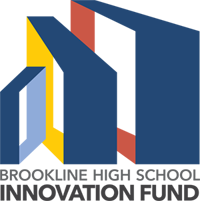



 The Racial Awareness Seminar is a year-long sophomore elective that was seeded by the 21st Century Fund in 2016-2017. This seminar-style class is designed to foster students’ capacity to reflect on and speak effectively about racial identity, and to create a learning community that embraces and is empowered by the rich diversity of identities and perspectives at BHS.
The Racial Awareness Seminar is a year-long sophomore elective that was seeded by the 21st Century Fund in 2016-2017. This seminar-style class is designed to foster students’ capacity to reflect on and speak effectively about racial identity, and to create a learning community that embraces and is empowered by the rich diversity of identities and perspectives at BHS.
